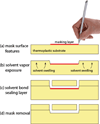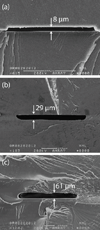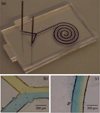Pen microfluidics: rapid desktop manufacturing of sealed thermoplastic microchannels
- PMID: 23344819
- PMCID: PMC3582333
- DOI: 10.1039/c2lc41057e
Pen microfluidics: rapid desktop manufacturing of sealed thermoplastic microchannels
Abstract
A unique technique for the rapid fabrication of thermoplastic microfluidic chips is described. The method enables the realization of fully-sealed microchannels in around one hour while requiring only minimal infrastructure by taking advantage of a solvent swelling mechanism that allows raised features to be patterned on the surface of homogeneous thermoplastic materials. Patterning is achieved without photolithography by simply drawing the desired microchannel pattern onto the polymer surface using a suitable ink as a masking layer, either manually or under robotic control, followed by timed exposure to solvent vapor to yield a desired depth for the masked channel features. The channels are then permanently sealed through solvent bonding of the microchannel chip to a mating thermoplastic substrate. The process is demonstrated using cyclic olefin copolymer as a thermoplastic material, with fully operational microfluidic devices fabricated following a true desktop manufacturing model suitable for rapid prototyping.
Figures






Similar articles
-
Microscale patterning of thermoplastic polymer surfaces by selective solvent swelling.Langmuir. 2012 Sep 4;28(35):12923-9. doi: 10.1021/la302704t. Epub 2012 Aug 23. Langmuir. 2012. PMID: 22900539 Free PMC article.
-
High-pressure on-chip mechanical valves for thermoplastic microfluidic devices.Lab Chip. 2009 Dec 21;9(24):3511-6. doi: 10.1039/b912014a. Epub 2009 Oct 6. Lab Chip. 2009. PMID: 20024030
-
Rapid prototyping of poly(methyl methacrylate) microfluidic systems using solvent imprinting and bonding.J Chromatogr A. 2007 Aug 31;1162(2):162-6. doi: 10.1016/j.chroma.2007.04.002. Epub 2007 Apr 8. J Chromatogr A. 2007. PMID: 17466320 Free PMC article.
-
Lamination-based rapid prototyping of microfluidic devices using flexible thermoplastic substrates.Electrophoresis. 2007 Apr;28(7):1115-22. doi: 10.1002/elps.200600503. Electrophoresis. 2007. PMID: 17330225
-
Recent Advances in Thermoplastic Microfluidic Bonding.Micromachines (Basel). 2022 Mar 20;13(3):486. doi: 10.3390/mi13030486. Micromachines (Basel). 2022. PMID: 35334777 Free PMC article. Review.
Cited by
-
Solvent immersion imprint lithography: A high-performance, semi-automated procedure.Biomicrofluidics. 2017 Apr 3;11(2):024111. doi: 10.1063/1.4979575. eCollection 2017 Mar. Biomicrofluidics. 2017. PMID: 28798847 Free PMC article.
-
Biomarker detection for disease diagnosis using cost-effective microfluidic platforms.Analyst. 2015 Nov 7;140(21):7062-81. doi: 10.1039/c5an00780a. Analyst. 2015. PMID: 26171467 Free PMC article. Review.
-
Micro total analysis systems: fundamental advances and biological applications.Anal Chem. 2014 Jan 7;86(1):95-118. doi: 10.1021/ac403688g. Epub 2013 Dec 13. Anal Chem. 2014. PMID: 24274655 Free PMC article. Review. No abstract available.
-
Polymer Microfluidics: Simple, Low-Cost Fabrication Process Bridging Academic Lab Research to Commercialized Production.Micromachines (Basel). 2016 Dec 10;7(12):225. doi: 10.3390/mi7120225. Micromachines (Basel). 2016. PMID: 30404397 Free PMC article. Review.
-
Single-use thermoplastic microfluidic burst valves enabling on-chip reagent storage.Microfluid Nanofluidics. 2015 May 1;18(5-6):1045-1053. doi: 10.1007/s10404-014-1494-8. Microfluid Nanofluidics. 2015. PMID: 25972774 Free PMC article.
References
-
- Xia Y, Whitesides GM. Annual Review of Materials Science. 1998;28:153–184.
-
- Lee JN, Park C, Whitesides GM. Analytical Chemistry. 2003;75:6544–6554. - PubMed
-
- Lucio do Lago C, Torres da Silva HD, Neves CA, Alves Brito-Neto JG, Fracassi da Silva JA. Analytical chemistry. 2003;75:3853–3858. - PubMed
-
- Liu A, He F, Wang K, Zhou T, Lu Y, Xia X. Lab Chip. 2005;5:974. - PubMed
-
- Coltro WKT, De Jesus DP, Da Silva JAF, Do Lago CL, Carrilho E. Electrophoresis. 2010;31:2487–2498. - PubMed
Publication types
MeSH terms
Substances
Grants and funding
LinkOut - more resources
Full Text Sources
Other Literature Sources

